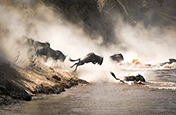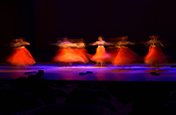Desert photography: The ultimate guide.
From sand dunes to saguaros, deserts are among the most breathtaking landscapes in the world. Learn how to transform empty expanses of blue sky and sand into dramatic desert landscape shots with advice from seasoned landscape photographers.
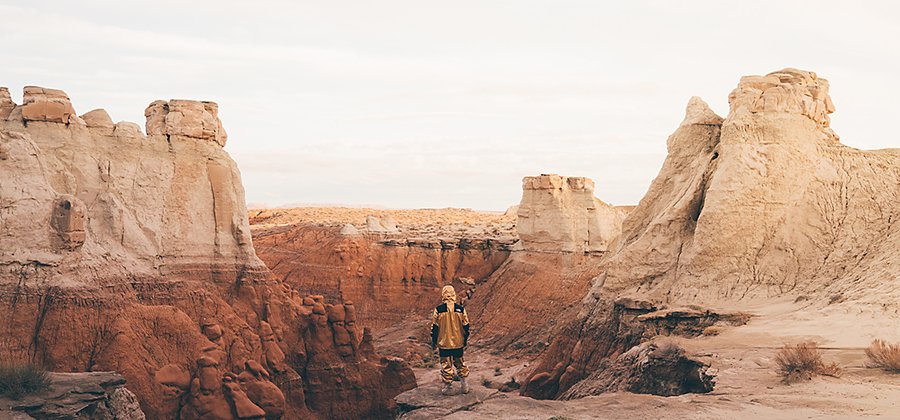
Soak up the sun and sand with desert photography.
The desert has long inspired artists and photographers thanks to its solitude and otherworldly terrain. Whether you find yourself in the rolling dunes of the Sahara or the red rocks of Utah and Arizona, the desert is truly a category of landscape photography all its own.
“Photographs of desert landscapes have an ability to transport people to these exotic and almost alien places. You’d never expect that mud cracks are exciting photographs, but they’re some of the most dramatic shots I’ve captured,” says photographer Julia Ohst. “People go to Death Valley National Park and scout for hours looking for the perfect little patch of mud cracks at sunset. When you see the final photo, it’s amazing.”
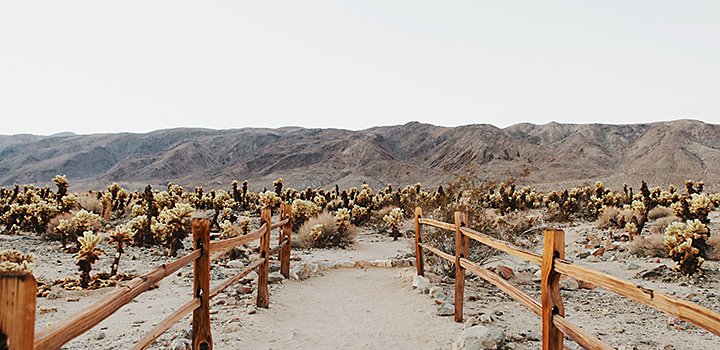
Desert landscapes are stark and arid, but never barren. Opportunities for creative compositions abound, if you know what to look for. “It’s a more minimalist style of photography, which allows you to think outside the box when creating,” says photographer Tiffany Nguyen.
How to prepare for a desert shoot.
Desert environments can be harsh and unpredictable, with extreme temperatures and weather conditions. Plus, it may take time for conditions to line up just right. It’s vital that you show up prepared, so you can stay safe and comfortable during your photoshoot.
“Bring plenty of water and sunscreen, sunglasses to protect your eyes and layers for when it gets cold,” says Ohst. Even if it’s hot during the day, consider packing a long-sleeved shirt and hat or scarf to protect yourself from the sun and possible high winds. Desert environments lose heat quickly once the sun goes down, so those protective layers can become warming layers at dusk.
Be ready to trek for the shot.
“To get to dunes without footprints in them, you may have to hike in a couple miles, so wear higher hiking boots or gaiters to avoid getting sand in your shoes,” says Ohst. She also recommends downloading a GPS app so you can mark good compositions while you scout and find your way back to the car. “It’s usually dark on the way in or out, so if you have a GPS there’s no risk of getting lost.”
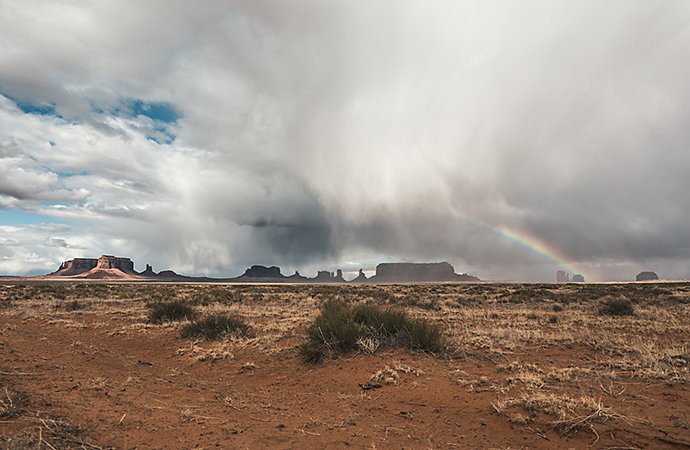

Watch the weather.
Desert weather can range from extreme heat to flash floods. Look up a weather report as you plan and when in doubt, err on the side of caution. “A place with slot canyons isn’t safe to be in during the rain. Sand doesn’t absorb water the same way earth does,” says Ohst.
On the other hand, rain and thunderstorms can be great opportunities to get the most dramatic scenes the desert has to offer. “If you can get something with a little more atmosphere, it’s really special and not what desert photographers usually have,” says Ohst. Pay attention to your surroundings; while beautiful, the desert can be dangerous in certain conditions.
Scope out the scene ahead of time.
Scouting makes all the difference when shooting in such a stark environment. “Composition is critical in the desert,” says Ohst. “It can look like there’s no story at first, so walk around before it’s go time to create some really compelling images.”
Look up images of the location online or search for popular points of interest to check out. As you walk around, take visual notes or drop a pin in your GPS so you can return to the composition later. If you want to shoot at sunrise or sunset, allowing plenty of time to scout is important, so you can make the most of those small windows of perfect light.
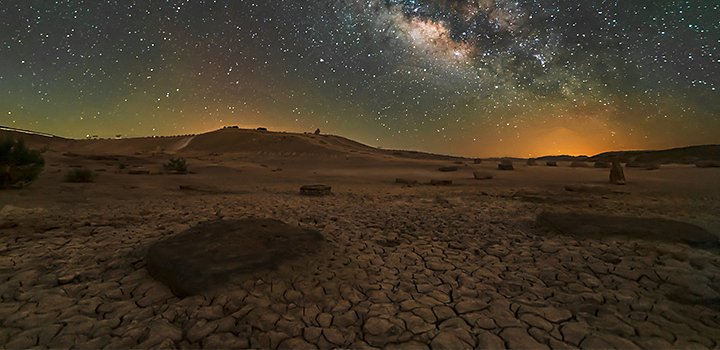
It’s doubly important for astrophotography, if you want to capture the night sky or Milky Way above the desert floor. It’s much easier to navigate the desert and dial in your camera settings in the daylight. The more you scout, the less stressful your actual shooting experience will be.
“Everywhere you look, there are decent compositions, but for something really special, going out an hour before sunset often isn’t enough prep time. Go in the morning or the middle of the day,” advises Ohst.
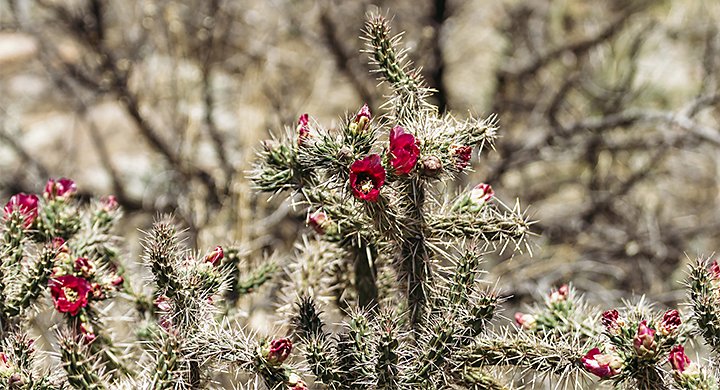
Be mindful of the surrounding ecosystem.
“Any plant you see in the desert worked hard to get there, so don’t walk on the little desert flowers. Know that your impact on the landscape can be lasting,” says Ohst. “Even what looks like a thin little crust on top of soil could be a microbiome that took 100 years to form.” Do some research on the location to find out how sensitive the environment is, as well as any rules or restrictions to follow during your visit. Make sure to find out what snakes, scorpions or other animals and insects you might need to look out for during your shoot.
Know your gear and how to take care of it.
Water is usually the first thing that comes to mind when people think of protecting their camera gear from the elements. But sand and wind are the more dangerous culprits to be wary of. They can scratch lenses and create internal buildup. Blowing sand can even damage your camera sensor.
“If there’s any wind at all, that dust or sand may get into the camera, lens, tripod or all three,” says Ohst. “Take care of that situation by using a rocket blower and little brushes to get sand out of crevices and threads, followed by a soft cloth to remove tiny dust particles. The longer you leave sand in, the more damage it causes.”
Keep gear you’re not using in your closed camera bag for maximum protection. You may even consider using a camera cover to block more wind and sand.
Check if your camera body is weather sealed or not. You don’t need a weather-sealed camera to shoot in the desert, but it lowers the likelihood of sand getting into your camera.
Avoid changing lenses while you’re in the desert. This is the best way to protect your camera and lens and it’s something you can do whether your camera is weather sealed or not. “Sand can go into your sensor and cause permanent damage. It can also scratch your glass, which can ruin your entire lens,” says Nguyen.
To protect the front element of your lens you can put an UV filter, polariser or neutral density filter on it, depending on the look you’re going for. Consider bringing or renting a second camera body, too. That way, you can put a wide-angle lens on one and a telephoto lens on the other and still be able to get a variety of focal lengths without separating your camera body and lens.
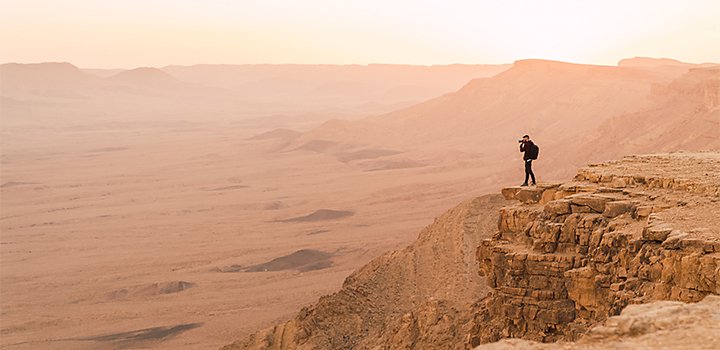
Expert photography tips for capturing unique shots.
Experiment with different lenses and compositions.
Just because it’s a flat landscape doesn’t mean your photos have to fall flat. All the usual rules for good composition apply in the desert — like light, shadow, texture and leading lines — and they’re even more important in such a stark landscape.
Try different lenses to make your image more dynamic. While a wide-angle lens is often the go-to for capturing the sweeping vistas, a telephoto or zoom lens can truly transform a landscape. “I recommend a telephoto lens to create a compression effect, which brings the foreground and background together,” says Nguyen.
Play with your colour palette.
“You have a minimal palette of colours to work with in the desert, so you may want to try to find a different colour that pops. If you’re shooting all red rock, look for something that stands out,” says Nguyen. Look for contrast and complementary colours in your scene. Something as simple as a patch of wildflowers or unique rock formation could be the ingredient that elevates your shot.
Look for natural patterns and shapes.
Everything from intricate mud cracks to the abstract shapes formed by the sand dunes can be striking subjects. “Look for lines,” advises Ohst. “S-curves are a really compelling composition in general, so if you can find a line that leads away from you and upwards, to me that’s the most interesting.”
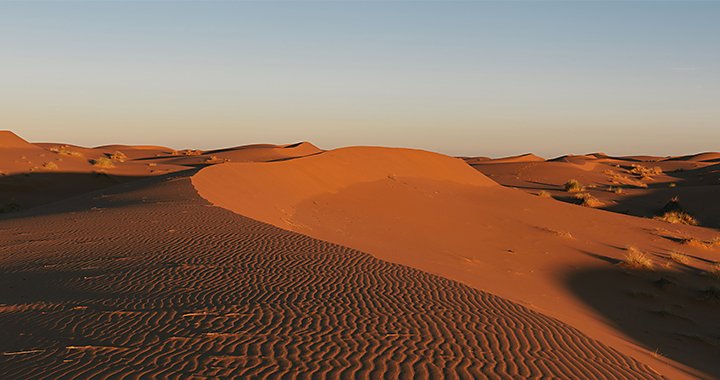
Shoot at golden hour.
Golden hour is the hour before sunset, famous for bathing landscapes in warm, soft light. It’s widely considered the best lighting condition for all types of photography. “I love using golden hour light to highlight texture,” says Ohst. “It works the best when it’s side-lit, showing ripples of sand with light coming from the side. Rather than shooting into the sun, which will give you lens flare, shoot perpendicular to the sun during golden hour.”
Get out and shoot.
Whether it’s your first time in the desert or your hundredth, there will always be something new and unexpected to photograph. Desert landscape photography requires a lot of planning, but with some forethought and a little luck, you can come away with some stunning shots. Most importantly, don’t forget to relax and enjoy the moment; the desert is an ideal place to experiment with your camera and enjoy time in nature off the beaten path.
Contributors
Do more with Adobe Photoshop Lightroom.
Edit photos easily with Lightroom presets, Super Resolution, easily share photos from any device and access your projects anywhere with cloud photo storage management.
You might also be interested in…
Tips for capturing nature photos of all kinds.
Explore the possibilities of nature photography, from animals in motion to sprawling landscapes.
Discover how adjusting shutter speed can help you capture clean shots or motion-filled moments.
What is ISO?
Discover the role this pillar of the exposure triangle plays in photography.
Introduction to black and white photography.
Learn to use black and white photography to hone photography skills and capture perfect photos.
Lightroom plan
Edit, organise, store and share photos from anywhere.
7 days free, then .
Photography
Get Lightroom, Lightroom Classic, Photoshop and 20 GB of cloud storage. 7 days free, then .
